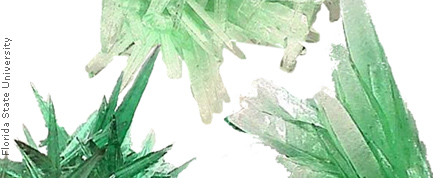Hidden Properties of Crystals Uncovered

This Behind the Scenes article was provided to LiveScience in partnership with the National Science Foundation.
Crystals made from simple organic compounds are found everywhere, even in dye for blue jeans, and are important for developing the scientific foundation behind organic electronics. Organic electronics can be cheaply and easily produced because they can be printed onto a substrate, much like one would print a paper or picture using an "ink" that is a mixture of organic materials. They are also flexible: imagine a digital newspaper which could be rolled up and placed in your backpack. Organic electronics offer such possibilities. Studying how properties depend on the molecule which builds the crystal and the resulting crystal structure will aid in developing this technology. During my summer stay at Nanyang Technological University (NTU) in Singapore as a National Science Foundation East Asia and Pacific Summer Institutes student, I studied the growth and properties of single crystals made from simple organic compounds. My colleagues and I were able to produce single crystals from a variety of molecules. We grew the crystals using an air-tight vaporization chamber. First we purified the powder which contained the material we were studying, heating the substance to almost 400 degrees Fahrenheit. Then, we placed the material in a growth tube where they evaporated and traveled down the tube to a cooler spot where crystals could form. We studied the crystals using liquid chromatography, which separates molecules based on their reaction with water, and luminescence, which works by shining a certain color of light on the material then observing what color it shines back. Using these techniques, we studied the crystals and observed signs of oxidation in a particular sample which has not previously been observed. We knew that it was oxidation because over the course of several weeks after growing the crystals, the color of light emitted would change. In other crystals, oxidation has been shown to have a significant impact on their performance, so studying this phenomenon will yield some beneficial insight. In addition to the research in the group, I was able to work with an ultrafast-laser science group at NTU, which is very similar to the research I do at the University of North Carolina now. Ultrafast laser researchers use laser pulses that are femtoseconds in duration, to study in real time how molecules react to light, such as vibrating and changing molecule structures. One femtosecond is one 1,000,000,000,000,000 of a second. We studied some of the samples together, and presently my advisor, Laurie McNeil, who also studies the optical properties of organic crystals, is working at NTU and is able to do experiments with them. The samples I produced last summer will be studied for my dissertation research, and I hope to travel back to Singapore to grow more samples and visit old friends. Although much work was accomplished inside the lab, just as much fun was accomplished outside. With my colleagues and the other graduate students from the United States, I was able to visit interesting places and historical sites (some more authentic than others), try all the amazing food, and live in a foreign place for the first time in my life. The neat thing about Singapore is how safe it is, and the melting pot of people who live there. The city's main population is Chinese, but there are substantial numbers of people from Malaysia and India. The coolest experience was taking the "jungle train" through Malayasia to the Perhentian Islands, near the Thai border. At the islands we went snorkeling and saw sharks, swam with sea turtles and observed dozens of marine species. We ate delicious, local cuisine at the beachside restaurant every night and hiked and kayaked around the islands. It was one of the most beautiful places I've ever been: you could literally see 20 to 30 feet in the water when snorkeling. It was a wonderful experience and I'm extremely thankful for the opportunity to have lived, studied and experienced life in such an interesting place.
- Top 10 Technologies That Will Transform Your Life
- Top 10 Emerging Environmental Technologies
- Diamond's Structural Secrets Revealed
Editor's Note: This research was supported by the National Science Foundation (NSF), the federal agency charged with funding basic research and education across all fields of science and engineering. Any opinions, findings, and conclusions or recommendations expressed in this material are those of the author and do not necessarily reflect the views of the National Science Foundation. See the Behind the Scenes Archive.
Sign up for the Live Science daily newsletter now
Get the world’s most fascinating discoveries delivered straight to your inbox.









